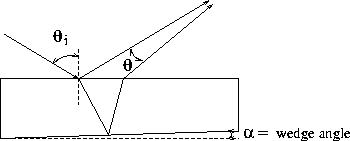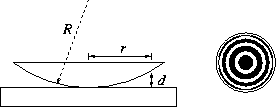For an interference pattern to be observable, the phase difference between the interfering waves must remain fairly constant in time. Light sources with good phase stability are said to be coherent. In amplitude-splitting interferometers, the two interfering waves are obtained by partial reflection and transmission of the same wave. These waves are usually delayed with respect to each other at the point of interference. Their phase difference remains constant in time if the light source is temporally coherent. Coherence time is the longest time delay for which the waves still show interference. In wavefront-splitting interferometers, the two interfering waves are obtained from different spatial regions of the same original wavefront. Their phase difference remains constant in time if the light source is spatially coherent. Coherence length is the longest distance on the wavefront for which the waves still interfere.
The fringe visibility (or fringe contrast) is defined as
Reflections from the front and back surfaces of a glass plate with a small wedge angle propagate in slightly different directions as shown in the figure. A screen placed on the beam path shows interference fringes. (For small angles of incidence, the intensity of the two beams are approximately equal; therefore, the fringe visibility is high.) This configuration is an example of an amplitude-splitting interferometer.

Derive an expression that relates the resulting fringe
separation ![]() to the wedge angle of the glass plate
to the wedge angle of the glass plate
![]() . (It is safe to assume that
. (It is safe to assume that ![]() is very small.) Find
the wedge angle of the glass plate from a measurement of the fringe
separation. To do this, expand the laser beam with a Galilean
telescope (
is very small.) Find
the wedge angle of the glass plate from a measurement of the fringe
separation. To do this, expand the laser beam with a Galilean
telescope (![]() mm and
mm and ![]() mm). Position the glass plate on the
angle measurement rotation base, as far from the laser as
possible. Adjust the angle of incidence so that a number of fringes
are visible on the reflected beam. To measure the fringe separation
mm). Position the glass plate on the
angle measurement rotation base, as far from the laser as
possible. Adjust the angle of incidence so that a number of fringes
are visible on the reflected beam. To measure the fringe separation
![]() accurately, count the number of fringes over a distance and
divide this measured distance to the number of fringes.
accurately, count the number of fringes over a distance and
divide this measured distance to the number of fringes.
The double slit experiment is also based on two wave interference. It is an example of a wavefront-splitting interferometer. Therefore, the fringe visibility is a measure of spatial coherence.
Expand the laser beam with a Galilean telescope (![]() mm and
mm and
![]() mm). Mount the component with double slits in a slide holder
and position it in the path of the beam. Select the 40
mm). Mount the component with double slits in a slide holder
and position it in the path of the beam. Select the 40 ![]() m wide
and 250
m wide
and 250 ![]() m spaced pair of slits with the aperture mask. (The
aperture mask should be placed right before the slits so that it has a
sharp shadow.) View the interference pattern on a piece of paper, far
from the slits. Slide the aperture mask horizontally to block one of
the slits and observe the interference pattern disappear. Illuminate
both slits again. Measure the fringe separation at a distance from the
slits. From this measurement, calculate the slit spacing using
Equation (2.5-8) and compare this with the given value. Repeat these
measurements for the 40
m spaced pair of slits with the aperture mask. (The
aperture mask should be placed right before the slits so that it has a
sharp shadow.) View the interference pattern on a piece of paper, far
from the slits. Slide the aperture mask horizontally to block one of
the slits and observe the interference pattern disappear. Illuminate
both slits again. Measure the fringe separation at a distance from the
slits. From this measurement, calculate the slit spacing using
Equation (2.5-8) and compare this with the given value. Repeat these
measurements for the 40 ![]() m wide and 500
m wide and 500 ![]() m spaced pair of
slits.
m spaced pair of
slits.
Repeat the same experiment with the incandescent light source. Position the slits far from the light source so that the spatial coherence is high. (More on this in Chapter 10.) Use the diffuser as a screen; look from the opposite side towards the light source. Move the light source closer to the slits and observe the drop in fringe visibility. Why do you think the visibility is a function of light source distance from the slits?
